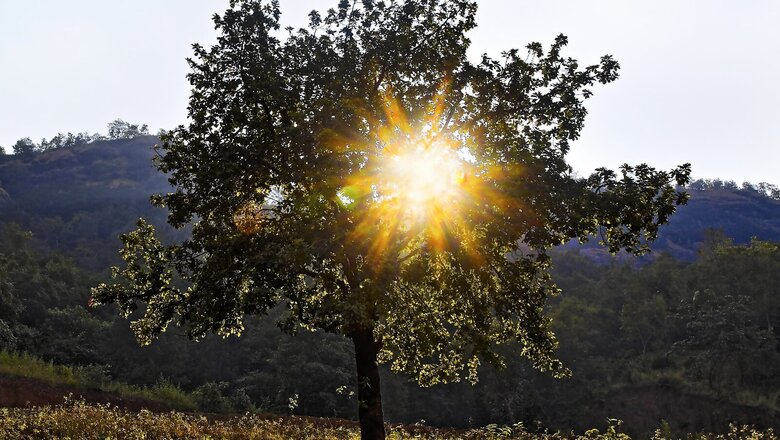
views
Since the 20th century, India has witnessed continuing change in weather conditions and consequent impact on human and economic capital. In fact, the Global Climate Risk Index 2020 ranks India as the fifth most affected country in the world due to climate crisis.
The average temperature over the Indian peninsula has risen by 0.7℃ from 1908-2018 and rainfall has decreased by 6 per cent, which means groundwater is not getting replenished. As a result, a billion people in India are said to experience water scarcity for at least a month every year and about 130 million face water shortage all through the year.
Since Indian agriculture is hugely dependent on rain, food adequacy is also impacted. Although the rainfall period has decreased, extreme rainfall events have increased over the years. A few tragic examples include Uttarakhand floods of 2013 that killed more than 4000 people, Chennai floods of 2015 that killed 500 people and displaced 1.8 million others and Kerala floods of 2018 that killed 483 people and caused catastrophic damage to housing and infrastructure. Frequency and spatial extent of droughts have increased. One such example is the severe drought of 2016-2018 that hit southern India because of low rainfall from the Northeast monsoon in the winters. It had resulted in a water crisis thus affecting agricultural productivity. In other words, India is well in the throes of climate change.
ALSO READ | One Last Prayer to Hanuman: Ramrao, Farmer Trapped by Debt and Despair, Takes the Plunge
The target and the most direct solution to tackling climate change is clear — to cut down on anthropogenic emissions rapidly and sequester the remaining. However, this seemingly simple solution has its practical challenges, especially for a country like India. With an alarmingly high hunger index and over 300 million poor, one of India’s primary goals is also to ensure food security and decent living standards for its people. Climate change is already causing loss of lives, land and livelihoods and the poorest are at climate risk twice over. About 70 per cent of Indian households depend on agriculture for their livelihoods, but are facing dire consequences of frequent droughts, low rainfall and other climate uncertainties. The repercussions are endless — from land degradation and over-exploitation of natural resources to loss of incomes, distress migration and abysmal quality of life — climate change is pushing the development indices into a downward spiral.
This puts India in a Catch-22 situation where we need to work on reducing the development deficit by strengthening infrastructure and industries, while keeping the emissions strictly under check. It is crucial that these changes are not seen in isolation, but in a more holistic manner. For instance, declining agricultural productivity is a result of poor soil health, depleting groundwater table, loss of biodiversity and resource-intensive farming practices.
Addressing these challenges would require that we adopt an ecosystems’ perspective and nature-based approach that ensures sustainability and complements the ongoing efforts to achieve net-zero targets. COP26 also recognised the importance of nature for both reducing emissions and building resilience to mitigate climate change impact. Ecosystem-based Adaptation (EbA) is a promising approach that strives to regain this balance by restoring the natural resources and also building adaptive capacities of people to combat the adverse impacts of climate change.
EbA Contributions to Climate Change Goals
The global goal on adaptation, while not as explicit as the mitigation goal, includes a focus on protecting and restoring ecosystems, by strengthening agriculture, protecting livelihoods and lives. Unfortunately, ecosystems in much of rural India, providing primary support to the poor, are highly degraded. Driven by sheer necessity and limited options, the needy often resort to unsustainable exploitation of natural resources, thereby causing long-term damage to the environment which further exacerbates climate change.
EbA is a low-cost, nature-based and pro-poor strategic approach that transforms the rural ecosystem in a sustainable manner. Besides reviving and restoring the natural landscape and promoting conventional and eco-friendly practices, EbA provides a comprehensive approach that helps strengthen people’s capabilities, boost local livelihoods, promote community health and well-being, and encourages inclusive and equitable participation.
This can potentially catalyse the process of climate change mitigation by enhancing the carbon absorption capacities of our environment, while also securing a better quality of life for the vulnerable poor.
The impact and potential of EbA in sequestering carbon and building resilience to climate change is based on concrete evidence across varied geographies. For instance, two decades of intensive ecosystem-based projects in drought-prone areas of Maharashtra have shown results such as a 30 per cent increase in the area under forest cover and plantation and an 8-9-fold increase in agricultural income. Even in more recent cases, where considerable watershed development work has already taken place, EbA interventions like focus on climate-resilient agricultural practices, water harvesting and water stewardship, biodiversity conservation and diversified livelihoods led to impacts such a 37 per cent rise in average income level, an 87 per cent increase in water storage capacity and significant drop in distress migration.
Similar trends are seen in the villages of Madhya Pradesh, with a drastically different landscape — of dense forest cover and water bodies. Decades of unsustainable farming practices have led to severe problems of soil erosion, vegetation loss and compounded impacts of climate changes. EbA-led interventions, over the years, have successfully replenished much of the lost resources. Over 50 per cent of the barren land is now cultivable and the soil carbon detachment has significantly reduced in the region. Our research indicates that soil carbon content in treated watersheds under an EbA approach increased by an average of 0.41 tonne carbon/hectare in 19 years. If scaled to the entire semi-arid land of India (95.7 million hectares), an approximate 39 metric tonnes of carbon or 144 metric tonnes of CO2 equivalent could be sequestered in soils by improved land management and conservation, which is equivalent to 12 per cent of all of India’s greenhouse gas emissions from land use in 2010.
ALSO READ | Why Climate Change Talk Must Focus on Water, Not Just Stay Obsessed with Carbon
Collective Action is the Only Option
EbA is a promising approach that can bring a remarkable shift in ecological health, community well-being and climate resilience. However, ecosystem restoration and climate change adaptation is also a path that requires consistent, long-term strategic efforts. Considering the rapid changes in climate and temperatures, we need to act urgently and use the power of collective action.
We need people and organisations to join collaboratives such as ECOBARI ((Ecosystem-based Adaptation for Resilient Incomes) that bring together research institutes, corporates, government agencies and civil society with the aim of upscaling EbA and promoting nature-based solutions. ECOBARI, launched in November 2021, is the first national network in India with the aim to be a leading platform that grounds EbA at scale through ‘science-practice-business’ partnerships, policy engagement and resource provisioning, to achieve the sustainable development goals, the land degradation neutrality and climate commitments of India.
The COVID-19 pandemic has reinforced the urgency of restoring this balance with nature while also highlighting the need for ensuring equity — issues that are ingrained in the principles of the EbA approach.
While governments across the world realise the urgent need to submit and implement stronger 2030 emission reduction targets, it is crucial that equal attention be paid to promoting greater equity and inclusiveness to achieve a just transition. Ecosystem-based Adaptation can play a crucial role in this journey.
Arjuna Srinidhi is associate thematic lead for climate change and ecosystem-based adaptation research at the WOTR Centre for Resilience Studies (W-CReS). The views expressed in this article are those of the author and do not represent the stand of this publication.
Read all the Latest Opinions here



















Comments
0 comment